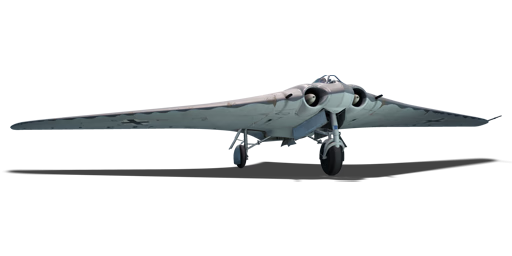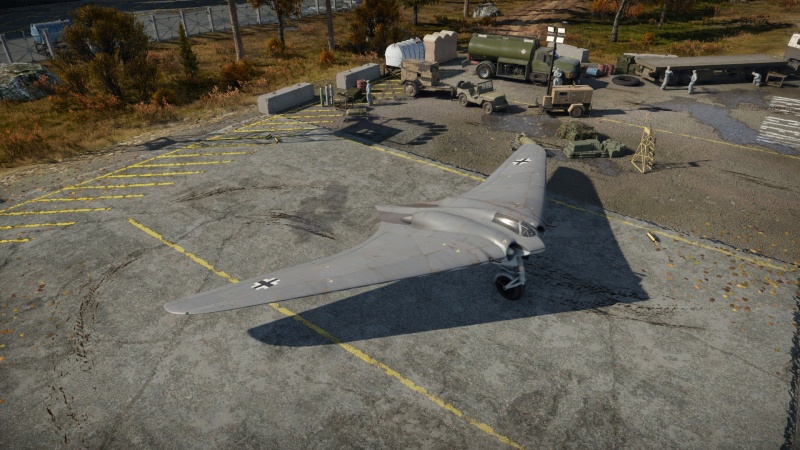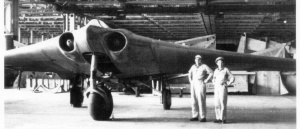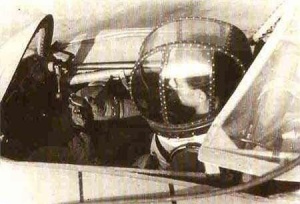Ho 229 V3
Contents
Description
The Ho 229 V3 is a rank V German jet fighter with a battle rating of 6.7 (AB), 7.0 (RB), and 7.7 (SB). It was introduced in Update 1.43.
The Ho 229 V3 is the first jet in the "Zerstörer" tech tree of the Luftwaffe and currently comes before the G.91 R/3. Ironically, it goes against much of the doctrine set by the previous planes, favouring speed and manoeuvrability over armament and durability.
Something that will immediately stand out with the Ho 229 V3 is how incredibly manoeuvrable it is compared to most other jet fighters. The Ho 229 V3 can almost quite literally turn on a dime and can even in some circumstances out-turn late super props such as the P-51H if manoeuvred correctly. However, if its manoeuvrability is used to its full extent, it also causes the plane to bleed speed at a crippling rate, making a sustained turn fight impossible to win. As such, it is advised to use the Ho 229 V3 as a Boom & Zoom fighter in order to maintain airspeed and altitude. Remember that jet engines' efficiency is directly proportional to the IAS, due to the increased air intake, meaning the Ho 229 V3 will be accelerating very slowly between 0-500 km/h, but beyond will be able to outrun any propeller-driven aircraft.
General info
Flight performance
| Characteristics | Max Speed (km/h at 8,000 m) |
Max altitude (metres) |
Turn time (seconds) |
Rate of climb (metres/second) |
Take-off run (metres) | |||
|---|---|---|---|---|---|---|---|---|
| AB | RB | AB | RB | AB | RB | |||
| Stock | 871 | 847 | 12000 | 24.8 | 25.4 | 17.0 | 16.1 | 850 |
| Upgraded | 950 | 910 | 23.4 | 24.0 | 25.5 | 21.0 | ||
Details
| Features | |||||
|---|---|---|---|---|---|
| Combat flaps | Take-off flaps | Landing flaps | Air brakes | Arrestor gear | Drogue chute |
| ✓ | ✓ | ✓ | ✓ | X | X |
| Limits | ||||||
|---|---|---|---|---|---|---|
| Wings (km/h) | Gear (km/h) | Flaps (km/h) | Max Static G | |||
| Combat | Take-off | Landing | + | - | ||
| 0 | 450 | 558 | 529 | 380 | ~10 | ~5 |
| Optimal velocities (km/h) | |||
|---|---|---|---|
| Ailerons | Rudder | Elevators | Radiator |
| < 570 | < 600 | < 420 | N/A |
Engine performance
| Engine | Aircraft mass | |||||||
|---|---|---|---|---|---|---|---|---|
| Engine name | Number | Empty mass | Wing loading (full fuel) | |||||
| Junkers Jumo 004D | 2 | 4,800 kg | 188 kg/m2 | |||||
| Engine characteristics | Mass with fuel (no weapons load) | Max Takeoff Weight | ||||||
| Weight (each) | Type | 17m fuel | 20m fuel | 30m fuel | 45m fuel | 57m fuel | ||
| 750 kg | Axial-flow turbojet | 5,541 kg | 5,667 kg | 6,088 kg | 6,720 kg | 7,255 kg | 7,500 kg | |
| Maximum engine thrust @ 0 m (RB / SB) | Thrust to weight ratio @ 0 m (100%) | |||||||
| Condition | 100% | WEP | 17m fuel | 20m fuel | 30m fuel | 45m fuel | 57m fuel | MTOW |
| Stationary | 1,050 kgf | N/A | 0.38 | 0.37 | 0.34 | 0.31 | 0.29 | 0.28 |
| Optimal | 1,050 kgf (0 km/h) |
N/A | 0.38 | 0.37 | 0.34 | 0.31 | 0.29 | 0.28 |
Survivability and armour
Examine the survivability of the aircraft. Note how vulnerable the structure is and how secure the pilot is, whether the fuel tanks are armoured, etc. Describe the armour, if there is any, and also mention the vulnerability of other critical aircraft systems.
Modifications and economy
Given the Horten's weight, the acceleration is an issue on the stock plane. Go for ammunition, engine and compressor upgrades first.
After that, any upgrade is equally good. Weapon upgrades can wait, as the Mk 103 is the best gun in-game, with high accuracy and long bursts stock. The belts also shouldn't be a priority unless using the Ho 229 as an attacker. In that case, the "Armoured targets" belt is very useful against tanks & light pillboxes.
Armaments
Offensive armament
The Ho 229 V3 is armed with:
- 2 x 30 mm MK 103 cannons, wing-mounted (170 rpg = 340 total)
Ammunition
- Default: HEI-T · I · AP-I; okay against planes.
- Armoured targets: HVAP-T · I · HVAP-T · AP-I; the armoured target belt is different for the Ho 229 V3, compared to all other Mk 103 armed aircraft, and is only a 1/2 as effective, due to the belt being filled with incendiary shells.
- Air targets: HEI-T · HEI · HEI · I; each Minengeschoß (mine-shell) has the same HE power as a 37 mm round, wonderful against anything that flies and light ground targets.
- Stealth: AP-I; difficult to use; cannot destroy most tanks nor pillboxes, lacks the destructive force of HE shells against planes.
Usage in battles
The Horten 229 flying wing is a dogfighter, heavy-fighter, or even an attacker.
Its single wing design allows for amazing manoeuvrability despite its weight of up to 8 tonnes, when equipped with full fuel load. This is, however, the Horten's literal downfall; the weight. Its acceleration is awful, even for jets. But the energy retention is great and climb acceptable. With that in mind rule number one of jet battle comes into play: do not turnfight! The 229 will tempt anyone though. The low wing loading for a jet and even some piston planes allows for tight turning circles. Being heavy also allows to keep that velocity well in the initial turns, but with the inability to regain that speed afterwards... leads to a flaming wreck thanks to an opportunistic enemy. The classic dogfight is thus only for emergency situations!
As a fighter, stick with Boom & Zoom, in which the Ho 229's heavy weight is of assistance in zoom climbs. However, it will also dampen the Horten's starting acceleration in a dive, making out diving an enemy difficult. The bad roll rate makes it hard to get some shots on target, But watch out! Don't pull too hard on the elevator to get that shot, or the Horten will lose much speed (which cannot be regained quickly) or rarely, lose a wing.
The heavy fighter role equals the fighter one in every aspect, just that the targets are usually bombers. Stay fast, and try to get shots off in head-ons, or in slight diving turns from the bomber's six (tail), to make it difficult for the defensive gunners to hit the Ho 229.
The attacker role is a dangerous one. The Ho 229 will have to fly slow, in order to have time to properly aim, hit & evade trees. While all of these aren't difficult in the Horten 229 V3, it leaves the plane in a dangerous spot: low and without speed. Both are vital though for the sluggish plane. In this role, be sure to have good escort fighters, as enemies can come at any time in jet combat.
Once the Horten is fully upgraded, or at least the performance parts are, one detail to notice is that the wings won't rip so easily like before, but the Ho 229 still has to turn cautiously, because it is still a wooden plane after all.
Perhaps the most dangerous enemy of the Horten 229 is the F-84 Thunderjet. Since the Thunderjet gets an air spawn it already has all the energy it needs to get around the map quickly. There are occasions when players spawn in late, only to be strafed by an F-84 Thunderjet on the runway. The Ho-229 is decent at accelerating once up to about 550 km/h, past that point, the Ho 229 becomes a V2 rocket in terms of acceleration until about ~750-800 km/h, then there will be a hard time accelerating again.
Pros and cons
Pros:
- Excellent armament, MK 103 is one of the best guns in the game
- Great ammunition supply with 170 rounds per gun
- Low wing loading, incredibly good at turning when flown at medium speeds (400-600 km/h)
- Good energy retention if not manoeuvred too harshly
- Outruns piston-engine aircraft and all Allied jets, except for the F-84 Thunderjet when up-tiered
- Low stall speed of 165 km/h
- Fast when diving if flown at medium to high speeds before committing to a dive
- The air brake can bleed airspeed efficiently
Cons:
- Acceleration is slow- even its initial acceleration in a dive
- Only 1/4 of its armoured target belt is comprised of HVAP-T shells, unlike other MK 103 equipped aircraft, which have only HVAP-T shells
- Is easy to hit, cause of the size
- Easy to destroy wings in hard turns at high speed
- Terrible yaw rotation
- Poor roll rate - Significantly hinders the ability to counter defensive scissors
- Slow rate of fire results in occasional misses when sweeping quickly behind enemies if aiming at wings, which have a thin profile
- Have to land slow, cause of the lack of brakes
- Loses speed quickly in elevator turns
- Gets matched against enemy jets that have superior performance
- The cannons have a large dispersion cone.
History
The Horten H.IX, RLM designation Ho 229 (or Gotha Go 229 for extensive re-design work done by Gotha to prepare the aircraft for mass production) was a German prototype fighter/bomber initially designed by Reimar and Walter Horten to be built by Gothaer Waggonfabrik late in World War II. It was the first flying wing to be powered by jet engines.
The design was a response to Hermann Göring's call for light bomber designs capable of meeting the "3×1000" requirement; namely, to carry 1,000 kilograms (2,200 lb) of bombs a distance of 1,000 kilometres (620 mi) with a speed of 1,000 kilometres per hour (620 mph). Only jets could provide the speed, but these were extremely fuel-hungry, so considerable effort had to be made to meet the range requirement. Based on a flying wing, the Ho 229 lacked all extraneous control surfaces to lower drag. It was the only design to come even close to the requirements, and received Göring's approval. Its ceiling was 15,000 metres (49,000 ft.In the early 1930s, the Horten brothers had become interested in the flying wing design as a method of improving the performance of gliders. The German government was funding glider clubs at the time because production of military and even motorized aircraft was forbidden by the Treaty of Versailles after World War I. The flying wing layout removed the need for a tail and associated control surfaces and theoretically offered the lowest possible weight, using wings that were relatively short and sturdy, and without the added drag of the fuselage. The result was the Horten H.IV.
In 1943, Reichsmarschall Göring issued a request for design proposals to produce a bomber that was capable of carrying a 1,000 kilograms (2,200 lb) load over 1,000 kilometres (620 mi) at 1,000 kilometres per hour (620 mph); the so-called "3×1000 project". Conventional German bombers could reach Allied command centers in Great Britain, but were suffering devastating losses from Allied fighters. At the time, there was no way to meet these goals—the new Junkers Jumo 004B turbojets could provide the required speed, but had excessive fuel consumption.
The Hortens concluded that the low-drag flying wing design could meet all of the goals: by reducing the drag, cruise power could be lowered to the point where the range requirement could be met. They put forward their private project, the H.IX, as the basis for the bomber. The Government Air Ministry (Reichsluftfahrtministerium) approved the Horten proposal, but ordered the addition of two 30 mm cannons, as they felt the aircraft would also be useful as a fighter due to its estimated top speed being significantly higher than that of any Allied aircraft.
The H.IX was of mixed construction, with the center pod made from welded steel tubing and wing spars built from wood. The wings were made from two thin, plywood panels glued together with a charcoal and sawdust mixture. The wing had a single main spar, penetrated by the jet engine inlets, and a secondary spar used for attaching the elevons. It was designed with a 7g load factor and a 1.8× safety rating; therefore, the aircraft had a 12.6g ultimate load rating. The wing's chord/thickness ratio ranged from 15% at the root to 8% at the wingtips. The aircraft utilized retractable tricycle landing gear, with the nosegear on the first two prototypes sourced from a He 177's tailwheel system, with the third prototype using an He 177A main gear wheelrim and tire on its custom-designed nosegear strutwork and wheel fork. A drogue parachute slowed the aircraft upon landing. The pilot sat on a primitive ejection seat. A special pressure suit was developed by Dräger. The aircraft was originally designed for the BMW 003 jet engine, but that engine was not quite ready, and the Junkers Jumo 004 engine was substituted.
Control was achieved with elevons and spoilers. The control system included both long-span (inboard) and short-span (outboard) spoilers, with the smaller outboard spoilers activated first. This system gave a smoother and more graceful control of yaw than would a single-spoiler system.
Given the difficulties in design and development, Russell Lee, the chair of the Aeronautics Department at the National Air and Space Museum, suggests an important purpose of the project for the Horten Brothers was to prevent them and their workers from being assigned to more dangerous roles by the German military.
Media
- Skins
- Videos
See also
Links to the articles on the War Thunder Wiki that you think will be useful for the reader, for example:
- reference to the series of the aircraft;
- links to approximate analogues of other nations and research trees.
External links
| Gothaer Vehicle Factory (Gothaer Waggonfabrik) | |
|---|---|
| Jet Fighters | Ho 229 V3 |
| Germany jet aircraft | |
|---|---|
| |
Luftwaffe |
| He 162 | He 162 A-1 · He 162 A-2 |
| Me 163 | Me 163 B · Me 163 B-0 |
| Ho 229 | Ho 229 V3 |
| Ar 234 | Ar 234 B-2 · Ar 234 C-3 |
| Me 262 | Me 262 A-1a · Me 262 A-1a/Jabo · Me 262 A-1a/U1 · Me 262 A-1/U4 · Me 262 A-2a |
| Me 262 C-1a · Me 262 C-2b | |
| |
LSK |
| Fighters | ◊MiG-15bis · ◊Lim-5P · ◊MiG-19S |
| ◊MiG-21MF · ◊MiG-21bis-SAU · ◊MiG-21 "Lazur-M" | |
| ◊MiG-29 | |
| Attackers | ◊MiG-23BN · ◊MiG-23MF · ◊MiG-23MLA |
| ◊Su-22UM3K · ◊Su-22M4 | |
| ◊IL-28 | |
| |
Luftwaffe |
| F-84 | ◄F-84F |
| F-86 | ◄CL-13A Mk 5 · ◄CL-13B Mk.6 · ◄F-86K |
| F-104 | ◄F-104G |
| F-4 | ◄F-4F Early · ◄F-4F · ◄F-4F KWS LV |
| G.91 | ◄G.91 R/3 · ◄G.91 R/4 |
| Tornado | ◄Tornado IDS WTD61 · ◄Tornado IDS MFG · ◄Tornado IDS ASSTA1 |
| Other | Alpha Jet A · ◄Sea Hawk Mk.100 |
| Ex-LSK | ◄MiG-21 SPS-K · ◄MiG-29G · ◄Su-22M4 WTD61 |
| |
Swiss Air Force |
| ◌Hunter F.58 · FFA P-16 | |







